Welcome to the Review: Uncorking Far Niente Chardonnay
Hello, fellow wine connoisseurs! Lily Tran here, your WSET Level 3 expert, and today, we’re uncorking a bottle that holds a truly iconic place in the heart of Napa Valley and American winemaking: the Far Niente Chardonnay.
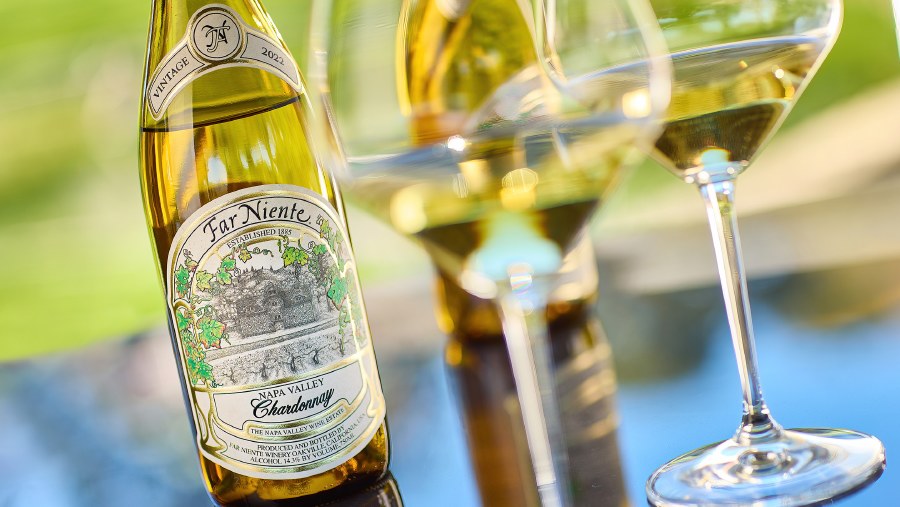
If you’ve ever explored the world of premium California white wines, chances are you’ve heard the name “Far Niente.” It evokes images of timeless elegance, meticulous craftsmanship, and that quintessential Napa Valley richness. But with a price tag that positions it firmly in the premium category, a crucial question arises: Is Far Niente Chardonnay worth it?
I remember the first time I tasted Far Niente Chardonnay. It was at a tasting event during my early WSET days, and I was still grappling with the vast spectrum of Chardonnay styles. I had tasted crisp Chablis, bright New Zealand examples, and even some very lean California Chardonnays. Then came Far Niente – opulent, layered, and undeniably luxurious. It was a revelation that showed me the incredible heights a carefully crafted, oak-influenced Chardonnay could reach. It redefined my understanding of “buttery” Chardonnay, transforming it from a caricature into a nuanced, elegant expression.
In this comprehensive Far Niente Chardonnay review, I’m not just going to give you a simple score. We’ll embark on a detailed exploration, covering:
- The rich history and winemaking philosophy behind this celebrated Napa winery.
- A meticulous, WSET-style tasting note of a recent vintage, dissecting its appearance, aromas, flavors, and overall structure.
- Expert food pairing recommendations to elevate your experience.
- An honest assessment of its aging potential.
- And, crucially, my expert verdict: Is this iconic Napa white wine truly worth the investment for you? We’ll also compare it to some of its peers, both from California and Burgundy.
So, pour yourself a glass (perhaps of another wine for now, unless you’re joining me with Far Niente!), get comfortable, and let’s delve into the intricate world of Far Niente Chardonnay.
Why Review Far Niente Chardonnay? An Iconic Napa Valley Statement
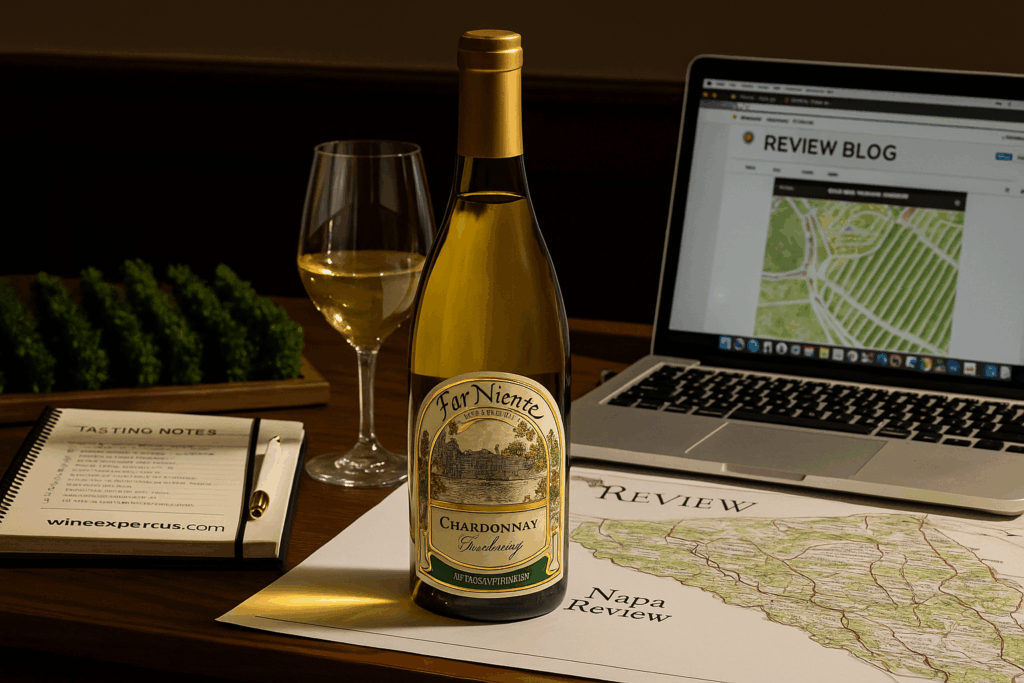
Choosing to dedicate a full pillar post review to Far Niente Chardonnay is no accident. This isn’t just another bottle; it’s a statement.
- Iconic Status: Far Niente has long been revered as a benchmark for premium Napa Valley Chardonnay. It’s a name frequently encountered by enthusiasts and aspiring collectors, making a detailed Far Niente Chardonnay review highly sought after.
- Distinctive Style: It represents a classic, rich, yet balanced style of California Chardonnay, perfected over decades. Understanding this wine helps consumers grasp a significant facet of Napa’s white wine identity.
- Price Point Justification: Its premium price tag naturally leads to the question of value. An in-depth review from a WSET expert provides the necessary analysis to help consumers decide if the quality justifies the cost for their palate and occasion.
- Educational Value: Dissecting Far Niente’s winemaking approach offers valuable insights into the techniques that shape many high-end Chardonnays, furthering the educational mission of WineExpertus.com.
- High Search Volume: The term “Far Niente Chardonnay review” sees significant monthly searches, indicating strong consumer interest and a clear opportunity to capture relevant organic traffic and provide authoritative content.
By reviewing such an iconic wine, we not only cater to a specific, high-intent search query but also elevate WineExpertus.com as a trusted source for authoritative wine analysis.
A Legacy of Excellence: The Story of Far Niente Winery
To truly appreciate Far Niente Chardonnay, one must understand the rich history and philosophy of the winery itself. Far Niente, meaning “without a care” in Italian, perfectly encapsulates the serene beauty and dedication to excellence found in this historic Napa Valley estate.
Historic Roots, Modern Vision
- Founded 1885: The original Far Niente winery was established in Oakville, Napa Valley, by John Benson, a forty-niner and uncle of the famous American artist Winslow Homer. It thrived until Prohibition forced its closure in 1919.
- Revival in 1979: The winery lay dormant for 60 years until it was purchased and lovingly restored by Gil and Beth Nickel in 1979. They undertook a meticulous three-year restoration project, bringing the stone winery and its caves back to life, blending historical preservation with modern winemaking capabilities.
- Pioneering Spirit: Far Niente was among the first wineries in California to dedicate itself solely to crafting single-varietal Chardonnay and Cabernet Sauvignon in a super-premium style, setting a high bar for quality in Napa.
- Sustainable Practices: From its solar energy program (one of the largest in the US wine industry) to its natural-flow gravity-fed winery, Far Niente is committed to sustainable and environmentally conscious winemaking, which adds another layer to its legacy.
Oakville’s Terroir: Home to Iconic Chardonnay
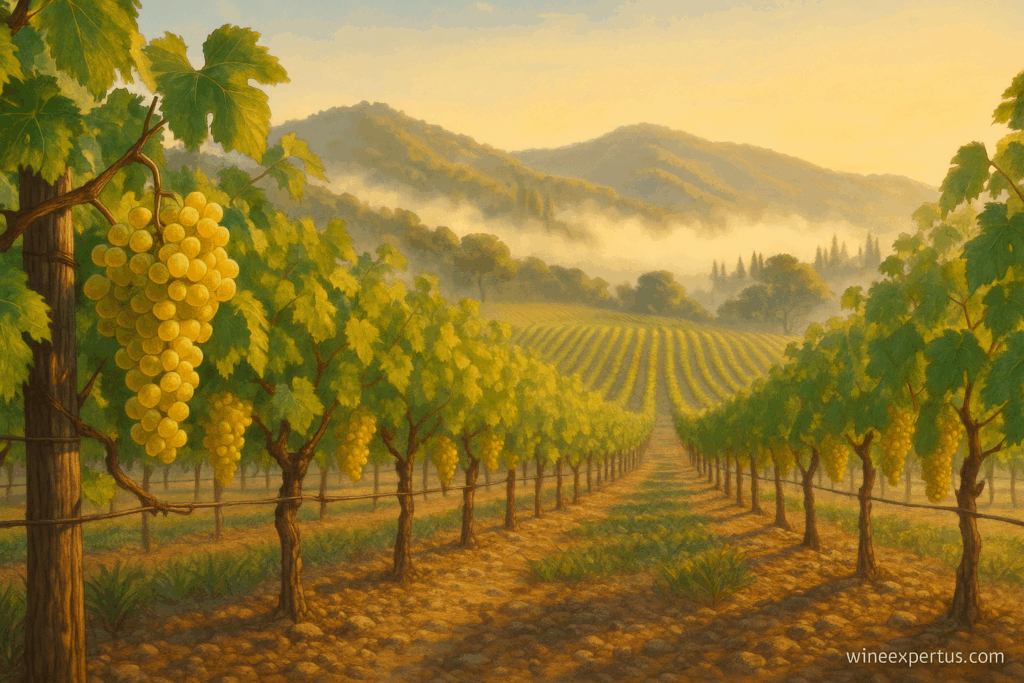
Far Niente’s estate vineyards are primarily located in the Oakville AVA (American Viticultural Area), a prestigious sub-region of Napa Valley.
- Climate: Oakville enjoys a warm, but not excessively hot, climate with cooling influences from the San Pablo Bay, particularly morning fog and afternoon breezes. This allows for long, even ripening.
- Soil: Predominantly well-drained, gravelly loam soils, which are ideal for viticulture, encouraging vines to dig deep for water and nutrients, leading to concentrated fruit.
- Lily’s Insight: The consistency and richness of Far Niente Chardonnay are deeply rooted in its Oakville terroir. While Napa as a whole is known for powerful wines, Oakville, particularly for Chardonnay, offers a balance of richness and freshness that allows the wine to shine. The unique microclimates and soils here contribute significantly to the distinct character you find in every bottle.
Far Niente Chardonnay: The Winemaking Philosophy
Far Niente’s approach to Chardonnay is a testament to precision and patience, deeply influencing its iconic style. They have a clear vision for their Chardonnay: richness, complexity, and age-worthiness, achieved through a set of consistent, thoughtful winemaking techniques.
Estate-Grown Grapes: Control from Vine to Bottle
- What it means: All grapes used for Far Niente Chardonnay are estate-grown from their vineyards in Oakville and Coombsville (a cooler AVA, providing freshness).
- Impact: This gives Far Niente complete control over viticultural practices, ensuring optimal ripeness, consistency, and quality from the very beginning. This “vine-to-bottle” philosophy is a hallmark of high-quality producers.
- Lily’s Insight: This level of control is crucial for wines aiming for consistency and premium quality year after year. It means they can precisely tailor their vineyard management to suit their desired Chardonnay style.
Barrel Fermentation & Extended Lees Aging: Building Complexity
- Barrel Fermentation: The unfermented Chardonnay juice is transferred directly into oak barrels for primary fermentation.
- Impact: This allows for slow, controlled fermentation, promoting integration of oak flavors and aromas, and contributing to a richer texture.
- Extended Lees Aging (Sur Lie): After fermentation, the wine remains in contact with its spent yeast cells (lees) in barrel for an extended period, typically 10-11 months.
- Impact: This technique (often combined with bâtonnage or lees stirring) adds layers of complexity, richness, and a creamy texture, contributing notes of brioche, toast, and nuts. It’s a key factor in the wine’s luxurious mouthfeel.
- Lily’s Insight: This combination is foundational to the Far Niente style. It’s how they build the profound texture and complexity that sets their Chardonnay apart.
Malolactic Fermentation: The Signature Creaminess
- What it is: All Far Niente Chardonnay undergoes 100% malolactic fermentation (MLF). This is a secondary fermentation that converts tart malic acid (like in green apples) into softer lactic acid (like in milk).
- Impact: Significantly reduces the wine’s acidity, resulting in a softer, smoother, and distinctly buttery or creamy texture. It also introduces flavors of butterscotch and hazelnut.
- Lily’s Insight: If you taste Far Niente Chardonnay and think “butter,” you’re tasting the direct result of this winemaking choice. This is a deliberate stylistic decision that defines their rich, opulent character.
No New Oak (Mostly) for Nuance
- What it means: While Far Niente Chardonnay is 100% barrel fermented and aged, they primarily use neutral (older) French oak barrels. They do not use new oak.
- Impact: This is a crucial nuance! It allows the texture and complexity from barrel fermentation and lees aging to develop without overwhelming the wine with overt vanilla, toast, or coconut flavors often associated with new oak. The focus is on integrating texture and subtle complexity, not bold oak flavors.
- Lily’s Insight: This is a sophisticated approach. Many perceive highly oaked Chardonnay as being all about new oak flavors. Far Niente demonstrates that oak’s primary contribution can be textural and savory complexity, making the wine rich but not “oaky” in the caricature sense. It’s about finesse within richness.
Far Niente Chardonnay Review: Lily Tran’s Detailed Tasting Notes (Vintage: 2022)
For this comprehensive Far Niente Chardonnay review, I tasted the 2022 Vintage. Please note that specific characteristics can vary slightly by vintage due to climatic conditions, but Far Niente maintains a remarkably consistent style.
- Wine: Far Niente Chardonnay, Napa Valley, USA
- Vintage: 2022
- Region: Napa Valley, California (primarily Oakville AVA)
- Price: ~$70 – $85 (Typical US Retail)
- Alcohol: 14.3% ABV
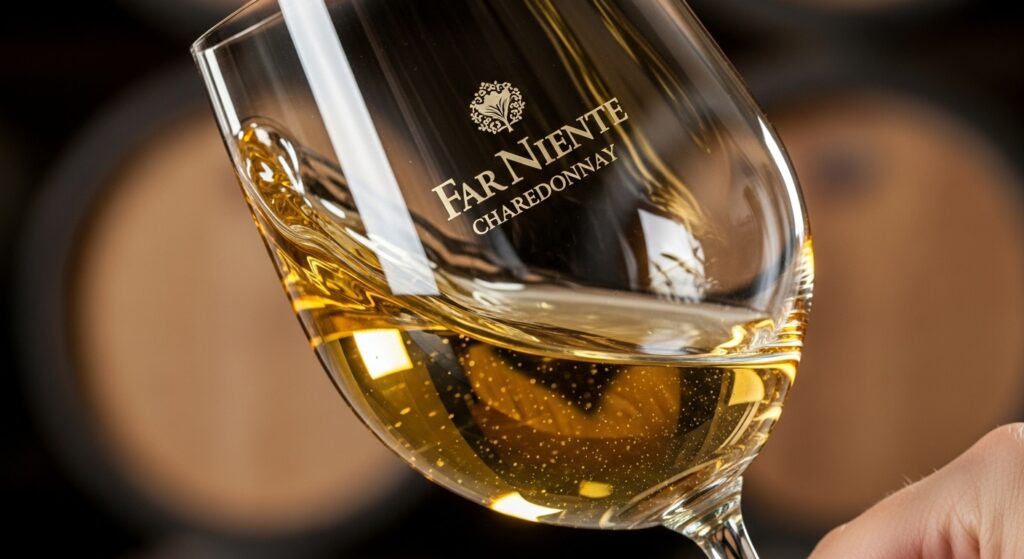
My sensory journey: The 2022 Far Niente Chardonnay under the WSET microscope.
Appearance: A Glimmer of Gold
- Clarity: Brilliant, perfectly clear.
- Intensity: Deep. This wine shows remarkable concentration.
- Color: A beautiful, radiant deep gold. This deep hue immediately signals richness and likely oak influence or ripeness, even before sniffing. Legs are abundant, slow-moving, indicating high alcohol and body.
Nose: A Symphony of Aromas
- Intensity: Pronounced. The aromas leap from the glass without aggressive swirling.
- Aromas:
- Primary (Fruit): Ripe yellow apple, baked pear, luscious peach, hints of pineapple and citrus zest (lemon curd). The fruit is ripe and inviting, not overtly tropical or sharp.
- Secondary (Winemaking): The characteristic notes of malolactic fermentation are beautifully evident: creamy butter, warm brioche, toasted hazelnut, and a delicate touch of vanilla bean (from barrel fermentation/aging). There’s a subtle underlying minerality that provides a counterpoint to the richness.
- Tertiary (Aging): Hints of toasted almond and a faint whisper of crème brûlée, suggesting thoughtful lees contact and bottle aging potential.
- Lily’s Impression: The nose is complex, harmonious, and utterly captivating. It’s a testament to the integrated winemaking. It’s rich, but with an underlying freshness that keeps it from being cloying.
Palate: The Full Sensory Experience
- Sweetness: Dry.
- Acidity: Medium. The acidity is present enough to provide freshness and prevent flabbiness, but it’s beautifully mellowed by the malolactic fermentation, creating a soft, rounded mouthfeel.
- Tannin: N/A (White Wine).
- Alcohol: High (14.3% ABV). The alcohol is well-integrated and contributes significantly to the wine’s full body and warmth, without being “hot” or burning.
- Body: Full. This is a substantial, opulent wine that fills the mouth.
- Flavor Intensity: Pronounced. The flavors mirror the nose beautifully, with intense concentration.
- Flavor Characteristics: On the palate, the ripe baked apple and peach notes are upfront, swiftly followed by layers of creamy butter, toasted brioche, and roasted nuts. A subtle citrus zest cuts through the richness on the mid-palate, adding a refreshing lift. There’s a mineral streak that provides complexity.
- Finish: Long. The flavors linger beautifully, evolving into notes of toasted almond and a creamy, lingering sensation.
Overall Impression: Balance, Complexity, & Length
- Balance: Excellent. All components – the ripe fruit, the creamy texture, the integrated oak, the acidity, and the alcohol – are in perfect harmony. Nothing dominates; everything supports.
- Length: Excellent. The prolonged finish speaks of quality and concentration.
- Intensity: Excellent. Both aromatically and on the palate, the wine delivers a powerful yet refined experience.
- Complexity: High. Layers of primary fruit, secondary winemaking notes, and subtle tertiary hints make this a wine that reveals itself gradually and rewards contemplation.
- Quality: Outstanding. This is a meticulously crafted wine that exemplifies the best of Napa Valley Chardonnay.
Food Pairing with Far Niente Chardonnay: Elevating the Experience
Far Niente Chardonnay’s richness, full body, and creamy texture make it an exceptional partner for a range of dishes, particularly those with similar richness or a need for a wine that can stand up to bold flavors. Understanding these Far Niente Chardonnay food pairing principles will maximize your enjoyment.
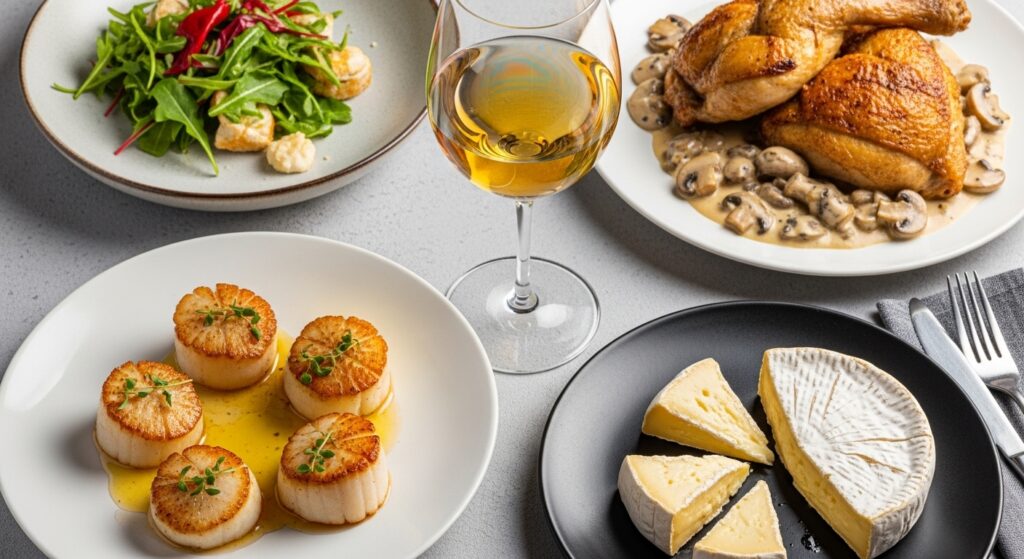
Elevate your meal: Perfect food pairings for Far Niente Chardonnay.
Classic Pairings: Why They Work
- Rich Seafood (Lobster, Crab, Scallops):
- Why: The wine’s full body and creamy texture perfectly match the richness of these indulgent seafoods. The buttery notes in the wine find a delicious echo in butter-poached lobster or crab cakes.
- Lily’s Insight: This is a classic for a reason! The synergy between the creamy wine and the sweet, rich seafood is unparalleled. Think pan-seared scallops with a brown butter sauce.
- Roasted Chicken or Turkey (with richer preparations):
- Why: The weight of the wine stands up to the poultry, especially if roasted with herbs or served with a creamy gravy or mushroom stuffing.
- Lily’s Insight: A celebratory roast chicken becomes truly magnificent with Far Niente. The wine is robust enough not to be overwhelmed.
- Creamy Pasta Dishes:
- Why: Dishes like Fettuccine Alfredo, pasta with a rich mushroom cream sauce, or lobster mac and cheese find a perfect textural and flavor match in the wine’s creaminess and buttery notes.
- Pork Tenderloin with Creamy Sauces:
- Why: The richness of the pork and the sauce are beautifully complemented by the wine’s body and flavor profile.
- Stronger, Creamy Cheeses:
- Why: Cheeses like aged Brie, Camembert, or a mature Gruyère can stand up to the wine’s intensity. The fat in the cheese interacts with the wine’s texture. For more insights, refer to our comprehensive guide on Wine and Cheese Pairing.
Lily’s Unexpected Pairings
- Miso-Glazed Black Cod: The savory umami and richness of the cod find a surprising harmony with the wine’s creamy texture and subtle nutty notes.
- Chicken Liver Pâté with Toasted Brioche: The rich, earthy pâté is beautifully complemented by the wine’s savory, buttery, and bready notes. It’s a truly indulgent match.
- Gourmet Mushroom Tart: If made with rich, earthy mushrooms and a buttery crust, this can be a sublime vegetarian pairing, as the earthy notes in the wine (subtly from lees aging) connect with the mushrooms.
Aging Potential of Far Niente Chardonnay: Patience Rewarded
One of the distinguishing characteristics of high-quality Chardonnay, like Far Niente Chardonnay, is its ability to age.
- Aging Capacity: Far Niente Chardonnay is built to age gracefully, typically developing further complexity over 5 to 10+ years from its vintage. Some exceptional vintages can age even longer.
- Evolution with Age:
- Aromas: The primary fruit (apple, peach, citrus) will evolve into more subtle, cooked fruit notes (baked apple, dried apricot), while secondary notes like butter and toast become more integrated. Tertiary aromas of hazelnut, honey, wet stone, and sometimes a hint of petrol or crème brûlée will emerge and deepen.
- Texture: The creamy texture tends to become even smoother and more integrated.
- Acidity: The acidity will soften slightly but remain a crucial backbone, maintaining freshness.
- Lily’s Insight: If you’re a collector or enjoy the nuanced evolution of aged white wines, Far Niente Chardonnay is an excellent candidate for your cellar. It rewards patience by revealing new layers of complexity that are not present in its youth. Ensure proper cellaring conditions (cool, dark, consistent temperature) to maximize its aging potential.
Is Far Niente Chardonnay Worth It? Lily’s Expert Verdict
After a thorough Far Niente Chardonnay review, the ultimate question remains: Does it justify its price tag (typically $70 – $85 in the US retail market)? My WSET expert verdict is a resounding yes, for the right wine lover and occasion.
The “Pros”: What Makes It Stand Out
- Exceptional Quality & Consistency: Far Niente consistently delivers a meticulously crafted, high-quality Chardonnay vintage after vintage. This consistency is a hallmark of truly great wineries.
- Benchmark Napa Style: It’s an iconic example of the rich, full-bodied, yet elegant Napa Valley Chardonnay style. If you love this particular style, Far Niente is a top-tier expression.
- Complexity & Depth: The winemaking (barrel fermentation, extended lees aging, MLF, neutral oak) results in a wine with impressive layers of aroma, flavor, and texture. It’s captivating and thought-provoking.
- Aging Potential: It offers genuine aging potential, allowing for further development and enjoyment over years.
- Elegant Oak Integration: Despite being barrel-fermented and having a buttery profile, the absence of new oak in aging prevents it from being overtly “oaky” or clumsy. The oak is seamlessly integrated, contributing to texture and nuance rather than overpowering fruit.
The “Cons” (Considerations): Is It For Everyone?
- Price Point: At $70-$85 a bottle, it’s a significant investment for many, placing it firmly in the premium category.
- Stylistic Preference: If you prefer lean, crisp, unoaked Chardonnay (like Chablis) or highly aromatic styles (like Sauvignon Blanc), this rich, buttery expression might not be your personal “best white wine.”
- Availability: While widely distributed in the US, it’s not a budget everyday wine.
Who is Far Niente Chardonnay Best For?
- Fans of Rich, Full-bodied Chardonnay: If your palate gravitates towards wines with creamy texture, notes of butter, baked apple, and ripe stone fruit.
- Special Occasions: Perfect for celebratory dinners, anniversaries, or impressing guests.
- Collectors: Those interested in aging Chardonnay and experiencing its evolution.
- Napa Valley Enthusiasts: If you want to experience a benchmark example of Napa’s classic Chardonnay style.
- Learning & Exploration: For anyone curious to taste a meticulously crafted, high-end expression of what Chardonnay can be.
Lily’s Insight: Far Niente Chardonnay is not an “everyday” wine for most. It’s a wine for contemplation, for special moments, and for appreciating the pinnacle of a particular winemaking philosophy. Its quality, consistency, and unique approach to oak (using neutral barrels) truly set it apart within the world of California Chardonnay.
Where to Buy Far Niente Chardonnay (in the US Market)
Far Niente Chardonnay is widely available across the United States due to its iconic status and established distribution.
- Fine Wine Retailers: Most independent wine shops specializing in premium wines will carry Far Niente.
- Major Wine & Spirits Chains: Larger chains like Total Wine & More, BevMo!, or Spec’s (in Texas) typically stock it.
- Online Retailers: Websites such as Wine.com, K&L Wine Merchants (for California residents), or specific online retailers that ship to your state are good options.
- Direct from Winery: You can also purchase directly from the Far Niente website, though shipping restrictions apply depending on your state.
Lily’s Tip: Prices can vary slightly between retailers. It’s always worth checking a few sources online to find the best red wine (or white wine!) deals.
Far Niente Chardonnay vs. The Competition: How It Stacks Up
To truly assess where Far Niente Chardonnay stands, it’s helpful to compare it to other prominent Chardonnays from various regions and styles. This is where my WSET training comes in handy!
Compared to Other Napa Chardonnays (e.g., Rombauer, Kistler)
- Rombauer Chardonnay: Often seen as the quintessential “big, buttery, oaky” Napa Chardonnay. Far Niente is also rich and buttery (due to MLF), but often exhibits more finesse and integrated oak character due to its use of neutral barrels and focus on estate fruit. Rombauer tends to be more overtly fruit-forward and sometimes heavier.
- Kistler Chardonnay: Known for its Burgundian-inspired approach, emphasizing subtle oak, minerality, and age-worthiness. Kistler often has more tension and less overt butteriness than Rombauer, but still delivers richness. Far Niente sits somewhere between Rombauer’s boldness and Kistler’s elegance, offering its own unique balance of power and restraint.
Compared to Grand Cru Burgundy (e.g., Meursault, Puligny-Montrachet)
- Burgundy (Old World): Emphasizes terroir and minerality above all else. While these wines can be rich, oaked, and undergo MLF, their fruit profile is typically leaner (green apple, citrus, stone fruit) and their minerality often more pronounced. They tend to be more savory, less overtly fruity/tropical than Napa.
- Far Niente: Represents the pinnacle of New World, particularly Californian, Chardonnay. It’s richer, more fruit-forward (stone fruit, baked apple, tropical hints), and its buttery character is often more pronounced. It offers a different, but equally valid, expression of high-quality Chardonnay. It’s like comparing a highly expressive American opera singer to a nuanced, traditional French one – both are excellent, just different styles!
Compared to Top Oregon Chardonnay (e.g., Lingua Franca, Domaine Drouhin)
- Oregon Chardonnay: Often aims for a style that balances the fruit ripeness of California with the elegance and acidity of Burgundy. They are generally less overtly buttery and oaky than many Napa Chardonnays, emphasizing crisp acidity, green apple, citrus, and subtle minerality.
- Far Niente: Is typically richer and more opulent than most Oregon Chardonnays, which lean towards a leaner, more precise style. If you prefer freshness and minerality over creaminess and fruit ripeness, Oregon might be a better everyday choice, but Far Niente delivers a distinct, luxurious experience.
Lily’s Insight: These comparisons aren’t about “better or worse,” but about understanding stylistic differences. Each offers a unique and valid interpretation of Chardonnay. The best red wine (or white wine!) for you depends entirely on your palate and the context.
Lily’s Personal Reflection: My Journey with Far Niente
My relationship with Far Niente Chardonnay has evolved over the years, much like a fine wine itself. When I first tasted it during my WSET studies, it was a benchmark, a gold standard for a particular style of rich Napa Chardonnay. It helped me understand the power of barrel fermentation and malolactic conversion in shaping a wine’s texture and flavor.
Later, as I explored more subtle and unoaked Chardonnays, I might have briefly drifted towards the “ABC” camp, finding some rich Chardonnays a bit too much for my everyday palate. But then, an occasion would arise – a celebratory dinner, a perfectly roasted chicken, or a decadent seafood dish – and Far Niente would call to me. Each time, I’m reminded of its inherent quality, its seamless integration of richness and elegance.
It’s a wine that has shown remarkable consistency across vintages, a true testament to the skill of the winemaking team and the quality of their estate vineyards. It’s a wine that doesn’t shy away from its bold Napa identity, yet always manages to maintain a sense of balance and sophistication. It reminds me that “big” doesn’t have to mean “clumsy.”
For me, Far Niente Chardonnay isn’t just a drink; it’s an experience. It’s a statement about Napa Valley, about dedication to craft, and about the sheer joy of a beautifully made wine. And yes, for the right moment, it is absolutely worth it.
Your Next Sip: Experiencing Far Niente Chardonnay
You’ve read the detailed Far Niente Chardonnay review. Now, it’s time to decide if this iconic Napa white wine is for you.
- If you’re a fan of rich, opulent Chardonnays: Put Far Niente on your must-try list.
- If you usually avoid buttery Chardonnays: Perhaps try a single glass at a restaurant first, or split a bottle with friends. You might be surprised by its elegance and how well the oak is integrated (or rather, the lack of overt new oak character).
- Consider the Occasion: This is not a casual weeknight wine for most. Save it for a special meal, a celebration, or a quiet evening of contemplation.
When you do uncork a bottle, take your time. Observe its beautiful golden hue. Inhale its complex aromas. Savor its rich, creamy texture on your palate. Pay attention to how it evolves in the glass. This is a wine that rewards your full attention.
FAQs: Far Niente Chardonnay Review
What does Far Niente Chardonnay taste like?
Far Niente Chardonnay is known for its rich, full-bodied, and creamy style. It typically presents aromas and flavors of ripe yellow apple, baked pear, peach, lemon curd, complemented by notes of butter, toasted brioche, hazelnut, and subtle vanilla from barrel fermentation and malolactic fermentation. It has a long, opulent finish.
Is Far Niente Chardonnay oaked?
Yes, Far Niente Chardonnay is 100% barrel fermented and aged. However, a key aspect of its winemaking is the primary use of neutral (older) French oak barrels, rather than new oak. This means it develops richness, creamy texture, and complex savory notes from the oak interaction and lees aging, but without the overt vanilla, toast, or coconut flavors typically associated with wines aged in new oak.
Where is Far Niente Chardonnay from?
Far Niente Chardonnay is produced in Napa Valley, California, USA. The winery’s estate vineyards are primarily located in the prestigious Oakville AVA, with some grapes also sourced from cooler sites in Coombsville.
What food pairs best with Far Niente Chardonnay?
The rich, full-bodied style of Far Niente Chardonnay pairs exceptionally well with rich seafood (like lobster with butter sauce, crab cakes, pan-seared scallops), roasted chicken or turkey (especially with creamy sauces), creamy pasta dishes, and pork tenderloin with delicate sauces. It also complements stronger, creamy cheeses like Brie or aged Gruyère.
How long can I age Far Niente Chardonnay?
Far Niente Chardonnay is designed to age gracefully. While enjoyable in its youth, it can develop further complexity over 5 to 10+ years from its vintage. In exceptional vintages and with proper cellaring, it can age even longer, evolving savory, nutty, and honeyed tertiary notes.
What is the typical price of Far Niente Chardonnay?
In the US retail market, Far Niente Chardonnay typically ranges from $70 to $85 per bottle. Its price reflects its iconic status, meticulous winemaking, and consistent high quality.
Is Far Niente Chardonnay considered a dry wine?
Yes, Far Niente Chardonnay is made in a dry style, meaning it has no perceptible residual sugar. Its perceived richness and sweetness come from its ripe fruit flavors, creamy texture, and notes derived from malolactic fermentation and oak aging, not from sugar.
Conclusion: An Enduring Icon of Napa Valley Chardonnay
The Far Niente Chardonnay stands as an enduring icon of Napa Valley. It represents a commitment to excellence, a deep understanding of its terroir, and a meticulous approach to winemaking that results in a Chardonnay of remarkable richness, complexity, and elegance.
While its price point positions it as a wine for special moments, its consistent quality and distinctive style make it a compelling choice for those who appreciate the pinnacle of New World Chardonnay. It’s more than just a wine; it’s an experience, a journey into the heart of what makes Napa Valley so revered.
If you’re seeking a white wine that truly delivers on its promise of luxury and depth, and you appreciate the art of winemaking reflected in every sip, then Far Niente Chardonnay is undoubtedly worth the exploration.
Cheers to discovering your next favorite icon!
Call to Action:
Ready to explore more iconic wines and deepen your appreciation? Join the WineExpertus.com community! Subscribe to our newsletter for exclusive reviews, expert tasting notes, and in-depth guides to the world’s most celebrated wines. Let’s continue this journey of discovery together!
